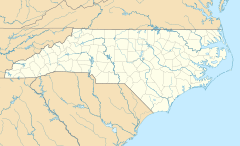Warsaw, North Carolina facts for kids
Quick facts for kids
Warsaw, North Carolina
|
|||
|---|---|---|---|

Front Street
|
|||
|
|||
| Country | United States | ||
| State | North Carolina | ||
| County | Duplin | ||
| Named for | the setting of Thaddeus of Warsaw | ||
| Area | |||
| • Total | 3.22 sq mi (8.33 km2) | ||
| • Land | 3.22 sq mi (8.33 km2) | ||
| • Water | 0.00 sq mi (0.00 km2) | ||
| Elevation | 154 ft (47 m) | ||
| Population
(2020)
|
|||
| • Total | 2,733 | ||
| • Density | 849.81/sq mi (328.14/km2) | ||
| Time zone | UTC-5 (Eastern (EST)) | ||
| • Summer (DST) | UTC-4 (EDT) | ||
| ZIP code |
28398
|
||
| Area codes | 910, 472 | ||
| FIPS code | 37-71160 | ||
| GNIS feature ID | 2406833 | ||
Warsaw is a small town located in Duplin County, North Carolina, in the United States. In 2020, about 2,733 people lived there. It's a quiet place with a rich history and a friendly community.
Contents
History of Warsaw
Warsaw has some interesting historical spots. Two places in town are so important that they are listed on the National Register of Historic Places. This is a special list of buildings, sites, and objects that are worth saving because of their historical meaning.
- The Warsaw Historic District is a whole area with many old buildings.
- The Joshua James Blanchard House is a specific historic home.
These places help tell the story of Warsaw's past.
Geography and Location
Warsaw is located in the western part of Duplin County. It's easy to get to, with major roads nearby.
- U.S. Route 117 goes right through the middle of town. It's known as Pine Street there.
- You can travel north on US 117 about 30 miles to reach Goldsboro.
- Going south on US 117 for about 19 miles will take you to Wallace.
- North Carolina Highway 50 (Memorial Drive) crosses US 117 at the north end of town.
- NC 50 leads east about 8 miles to Kenansville, which is the main town for Duplin County.
- Interstate 40 passes just south and west of Warsaw. You can get on I-40 from US 117 or NC 24.
The town covers a total area of about 3.05 square miles (7.9 square kilometers). All of this area is land, with no large bodies of water.
Population and People
The number of people living in Warsaw has changed over the years. Here's how the population has grown and shifted:
| Historical population | |||
|---|---|---|---|
| Census | Pop. | %± | |
| 1880 | 182 | — | |
| 1890 | 401 | 120.3% | |
| 1900 | 576 | 43.6% | |
| 1910 | 723 | 25.5% | |
| 1920 | 1,108 | 53.3% | |
| 1930 | 1,222 | 10.3% | |
| 1940 | 1,483 | 21.4% | |
| 1950 | 1,598 | 7.8% | |
| 1960 | 2,221 | 39.0% | |
| 1970 | 2,701 | 21.6% | |
| 1980 | 2,910 | 7.7% | |
| 1990 | 2,859 | −1.8% | |
| 2000 | 3,051 | 6.7% | |
| 2010 | 3,054 | 0.1% | |
| 2020 | 2,733 | −10.5% | |
| U.S. Decennial Census | |||
People Living in Warsaw (2020)
In 2020, the town of Warsaw was home to 2,733 people. These people lived in 1,139 households, and 547 of these were families. Warsaw is a diverse community, meaning people from many different backgrounds live there.
Here's a look at the different groups of people who call Warsaw home:
| Group | Number of People | Percentage |
|---|---|---|
| White (not Hispanic or Latino) | 652 | 23.86% |
| Black or African American (not Hispanic or Latino) | 1,497 | 54.77% |
| Native American | 5 | 0.18% |
| Asian | 19 | 0.7% |
| Other/Mixed (two or more races) | 60 | 2.2% |
| Hispanic or Latino (any race) | 500 | 18.29% |
Notable People from Warsaw
- Lucile Aycock McKee (1919—2013) was born in Warsaw. She was known for being the president of the Junior League of Raleigh, a group that helps communities.
See also
 In Spanish: Warsaw (Carolina del Norte) para niños
In Spanish: Warsaw (Carolina del Norte) para niños





